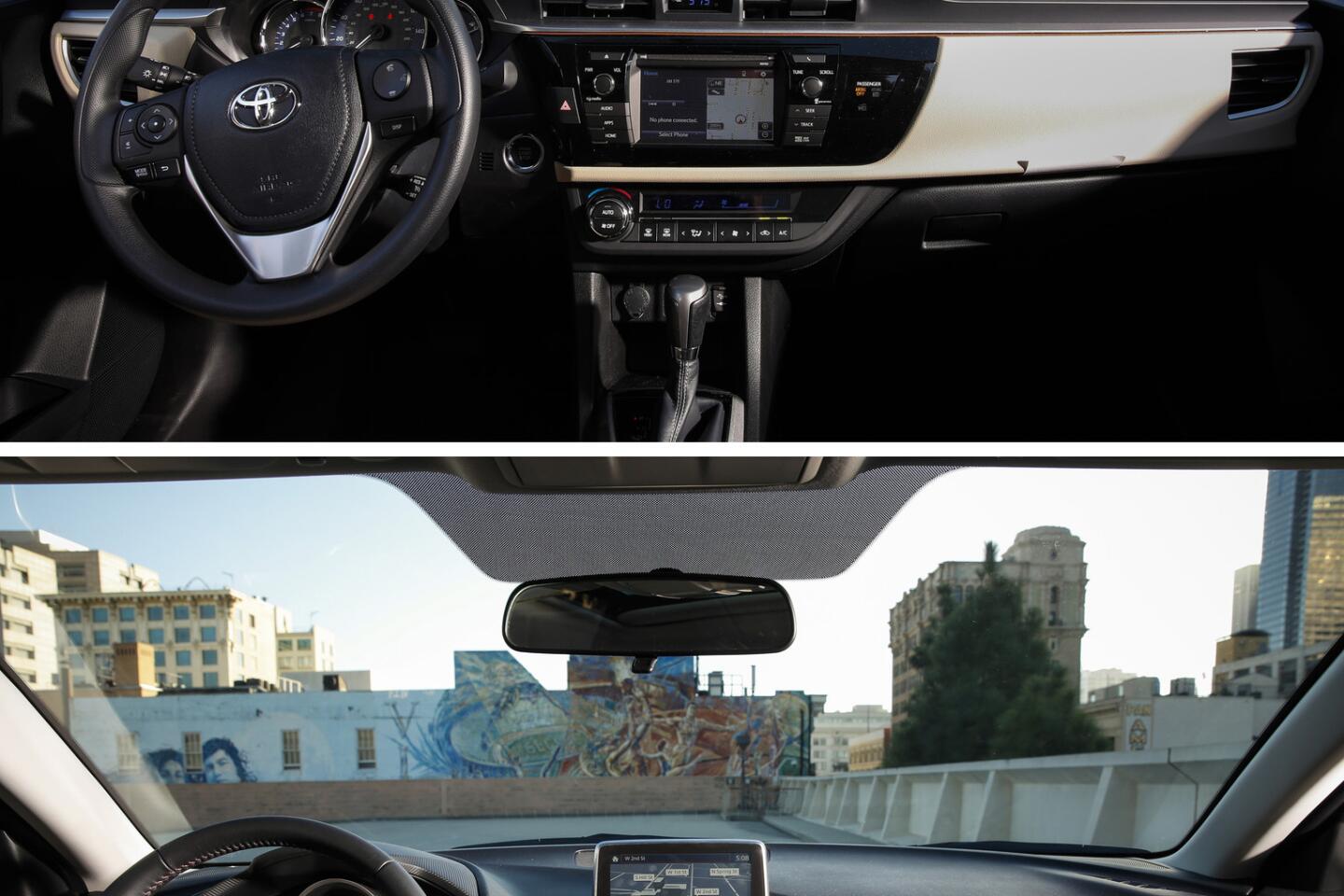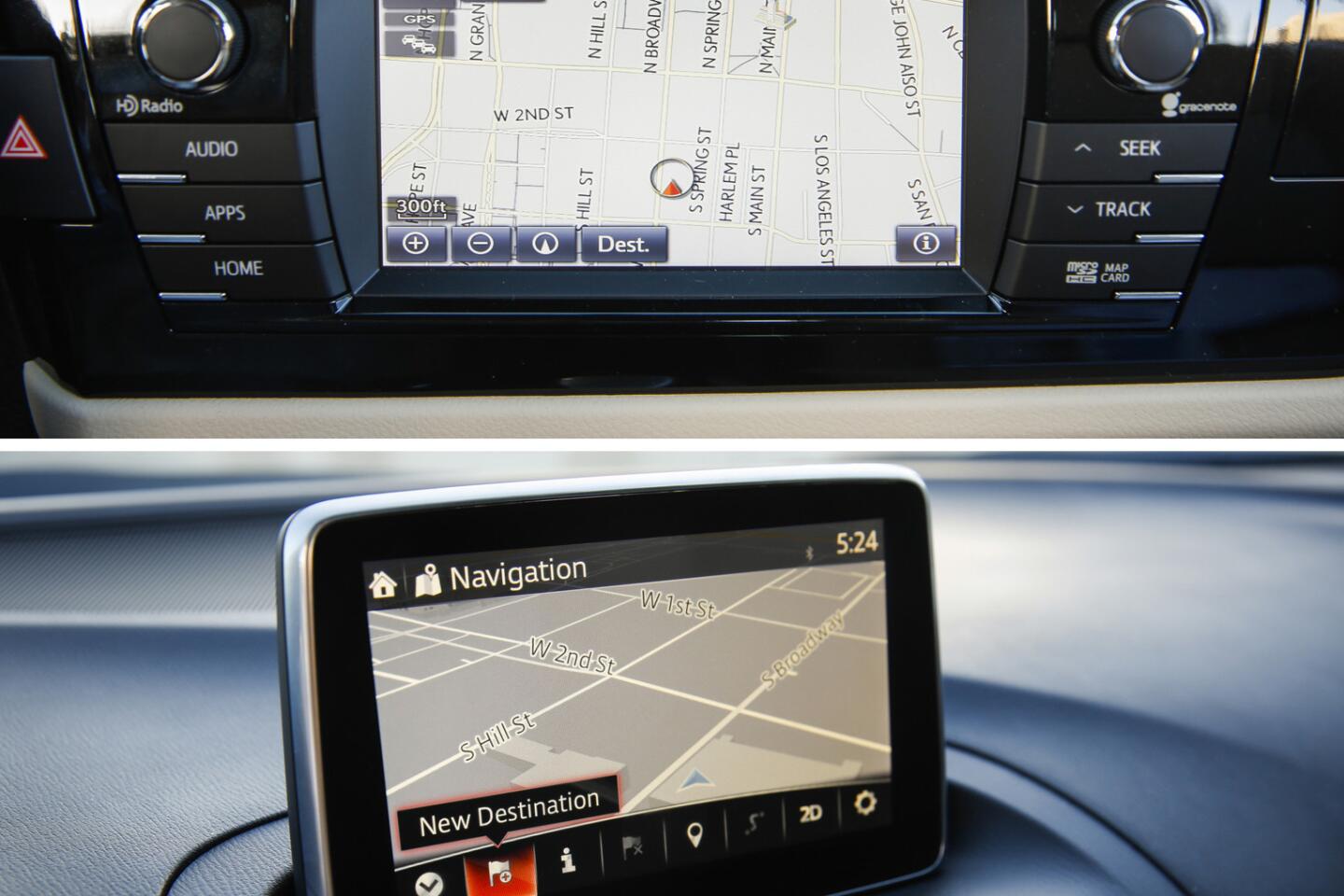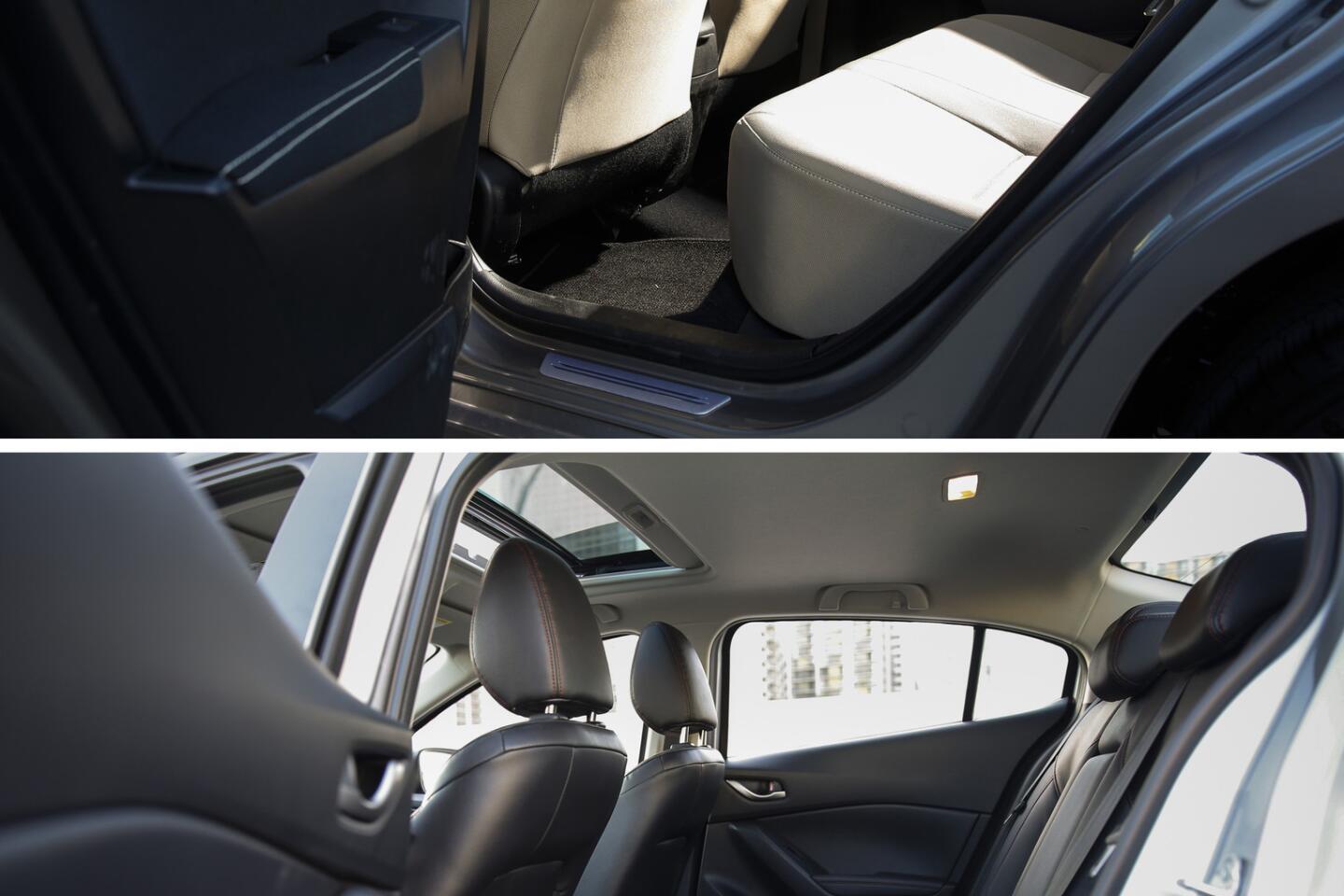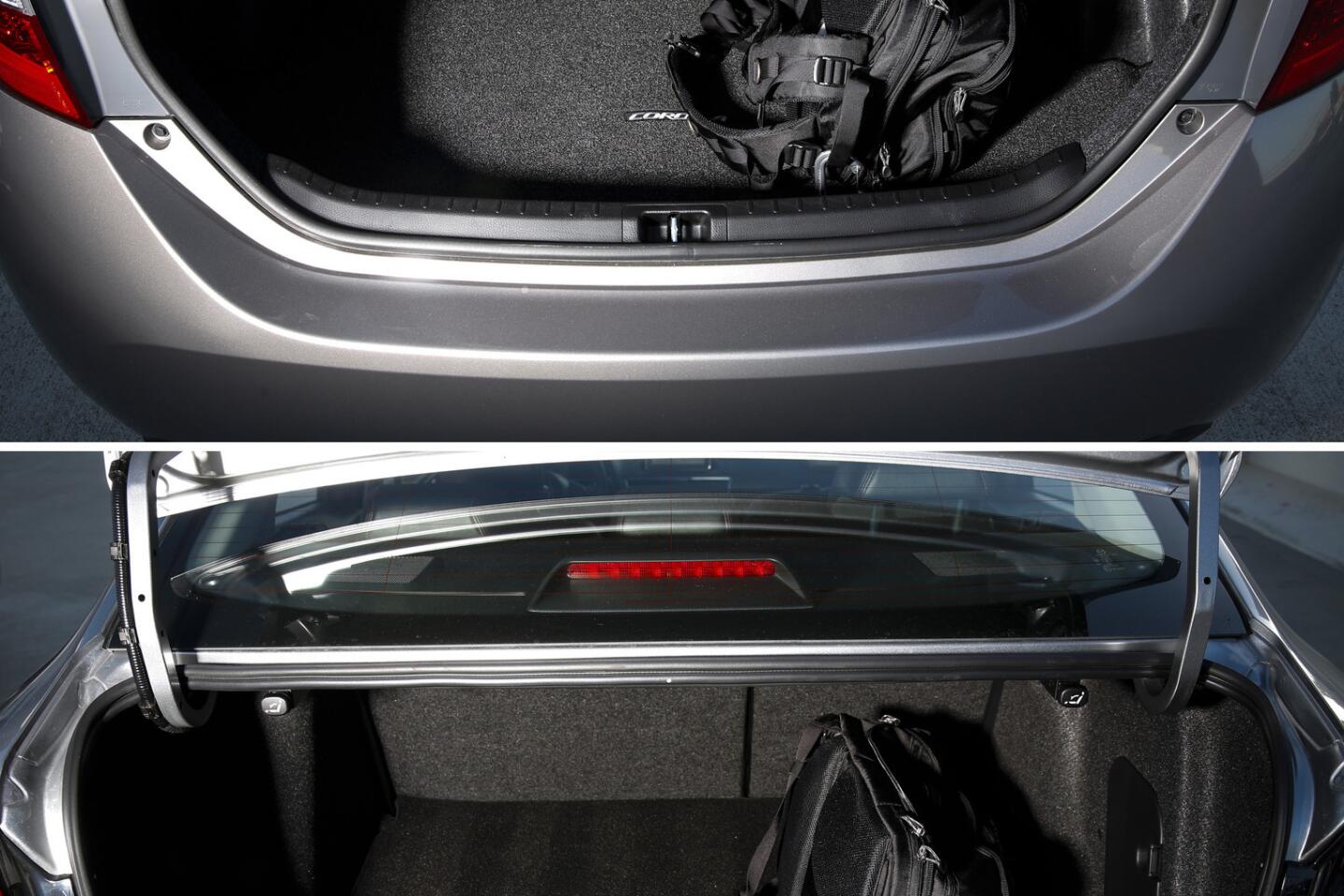New Toyota Corolla is much improved, but new Mazda3 outshines it
Compact cars are like toasters. Almost everyone, at some point, has owned one. They do their job without drama. Only rarely do they burn you.
Automakers have traditionally played it safe in this segment, the automotive equivalent of selling appliances: The products are designed for a simple task, without much thought to style or fun. Compacts are often a buyer’s introduction to a brand. The cars’ size, price and practicality appeals to a wide swath of customers, whom automakers hope to hook for more expensive purchases throughout their lifetimes.
No automaker has played it safer here than Toyota with its Corolla, which despite — or perhaps because of — its vanilla styling and squishy handling has been the appliance of choice for about a quarter million people a year over the last decade.
Playing yin to the Corolla’s yang has been the Mazda3, long marketed as the fun-to-drive econobox, with edgier styling and class-leading performance. This has worked less well for Mazda, which has remained more of a niche player despite consistent praise from critics. Toyota sells two or three times as many Corollas as Mazda sells 3s.
And yet, Toyota’s chief goal in the latest Corolla redesign was to inject more aggressive styling and performance. Go figure.
Mazda, meanwhile, has tried to edge its 3 more toward the mainstream, upping practicality and efficiency without abandoning its sporting character.
Both the Mazda and Toyota are all new for 2014. Consider yourself lucky if either lands on your shopping list or in your driveway. In addition, each reflects the growing competitiveness of cars in this segment. The 3 and the Corolla are each rich in features unheard of in compact cars 10 years ago. “It’s really been stunning to see how it’s evolved,” Mike Wall, an auto analyst at IHS, said of what a buyer can get in one of these cars today. “It wasn’t that long ago we were talking about crank windows,” Wall said.
Now leather seats, blind-spot monitoring and touch-screen navigation systems are common as automakers go the extra mile to please a growing customer base. With all this change in the air, we grabbed a 2014 Mazda3 and a 2014 Toyota Corolla to see how each balanced its past successes with its future goals.
Toyota Corolla
Messing with the Corolla formula represents a risk for Toyota, which has sold 40 million of the compacts globally since the model’s introduction in 1966. A quarter of those have been in the U.S. alone and 4.5 million are still on the road today, according to Toyota.
The latest Corolla — now in its 11th generation — is now rolling into dealerships. Toyota is hoping to reclaim the sales crown it lost to the Honda Civic in 2012. Among the biggest changes is the transmission, the first continuously variable gearbox the automaker has offered in the United States.
CVTs are essentially one-speed transmissions that don’t technically shift, and they are increasingly popular across the industry as a fuel-saving measure. But Toyota’s engineers built in artificial shift points to avoid CVTs’ annoying tendency to make the engine drone at higher revs, along with a Sport mode that elevates the RPM levels where those shift points occur.
That makes the transmission acts like a crisp-shifting automatic without losing the fuel-saving benefits of a CVT, an impressive feat. During my week of testing the car, I averaged 25 miles per gallon in mostly city driving.
Our test car was the Corolla Eco. It uses the same 1.8-liter four-cylinder engine as the base Corolla, but adds $1,100 to the price and offers a boost in power — from 132 horsepower to 140 — as well as efficiency, hitting 40 mpg in highway driving.
This engine gave our $22,694 tester perfectly adequate power for daily driving. When pushed hard, however, it lacked the refinement and strength of the Mazda. The Sport setting did little to spice things up in the performance department.
Another key change to the new Corolla is its size. You wouldn’t know by looking at it, but the wheelbase of this 2014 model is roughly 4 inches longer, and the car itself is 2 1/2 inches longer. That allows for a cavernous back seat, far outpacing its compact competitors — including the Mazda — in rear space.
That made any seat in the Corolla a good one, and the front seats mimicked the shape of the supremely comfortable seats we recently tested in the new IS from Lexus, Toyota’s luxury division. If only the Corolla’s cloth fabric weren’t so abrasive.
Further comfort comes from the Corolla’s quiet, comfortable ride. The doors close with a satisfying thud that is absent in Toyota’s current Camry and RAV4 sport-utility vehicle. The smooth ride came with some trade-off in handling, which didn’t match the sporty feel of the Mazda. Rubbery steering didn’t help. But it certainly handled well enough to please the vast majority of Corolla buyers.
Inside, buyers get a lot of value for their money. Our tester came with a great touch-screen navigation system with traffic alerts, a backup camera, LED daytime running lights, a large moon roof and an eco drive mode. One weakness: The Corolla is among the few compacts fitted with less-expensive drum brakes, rather than discs, at the rear wheels.
Overall, Toyota did a mighty good job improving this Corolla, which will no doubt continue to place high on sales charts. It fails to hit the standard set by the Civic, but it’s close. Sporty? No. But it’s sportier. That’s a start.
Mazda3
Since its introduction in 2004, the Mazda3 has earned applause from critics and driving enthusiasts alike. The general public doesn’t hate it either, as the 3 has far outsold anything else Mazda makes.
But its sales are still just a drop in the bucket for the high-volume segment; consider that in the U.S., Toyota sells more Corollas every year than Mazda sells vehicles in its entire lineup.
So for this third-generation 3, Mazda looked to juice sales and broaden its appeal by injecting more technology, safety and efficiency. It worked. Although the 3 costs a bit more in a class where every dollar counts, those willing to spare the money will be treated well.
As with previous generations, the 3 comes in either sedan or hatchback form with two four-cylinder engines offered. We tested a loaded $24,785 Grand Touring sedan with the smaller engine — the one Mazda expects more buyers to grab.
Mazda wrings 155 horsepower and 150 pound-feet of torque out of 2 liters, besting the Toyota and making the 3 pull and sound strong no matter how hard you lean into it. A six-speed automatic transmission ripped off crisp, well-timed shifts. With an EPA rating of 30 mpg in the city and 41 on the highway, we averaged 26 mpg in a week of mostly city driving, a virtual tie with the Toyota Corolla.
This powerplant plays well with the sharp handling, carried over from previous 3s, and is still the best in this class. Ride quality is a bit on the firm side. But where the 3 really shines is its safety and refinement. Mazda says it used luxury compact sedans like BMW’s 3-Series as benchmarks for its interior. That’s a common line in less-expensive segments (no one aims down), but in this case it rings true.
Dash controls and a wonderfully straightforward touch screen have an Audi-like quality to them. They’re even nicer than what you’ll find on the larger Mazda6 sedan. Leather covers the heated seats, steering wheel and shifter.
Safety is another win. As mentioned, all 3s have four-wheel disc brakes, unlike the Corolla. And the Grand Touring model we tested came with blind-spot monitoring and a cross-traffic alert on the backup camera. The Corolla’s only trump card in safety was its eight air bags, compared with the Mazda’s six.
But the 3 trails the Corolla in interior space. Although the wheelbase on this new Mazda has grown 2.4 inches, the rear seat is tight on legroom for tall people. The Mazda’s passenger volume and trunk space are also down.
And the extra goodies on the 3 aren’t free. The model we tested was about $1,000 more than a similarly equipped Corolla. But the price difference is worth it.
The verdict
With its unmatched handling, refinement and safety features, the Mazda3 gets the edge in our comparison test despite its higher price.
The Corolla represents a huge leap forward for Toyota, and it makes good on the company’s promise to build more exciting cars. It also offers more comfort and space — attributes high on compact buyers’ lists. But this isn’t enough to overcome the Mazda’s advantages.
The 3 jumps to the top of the compact segment with the Honda Civic and should be on anyone’s shopping list — even those of people who just want a toaster.
david.undercoffler@latimes.com
Twitter: @latimes_driven
















